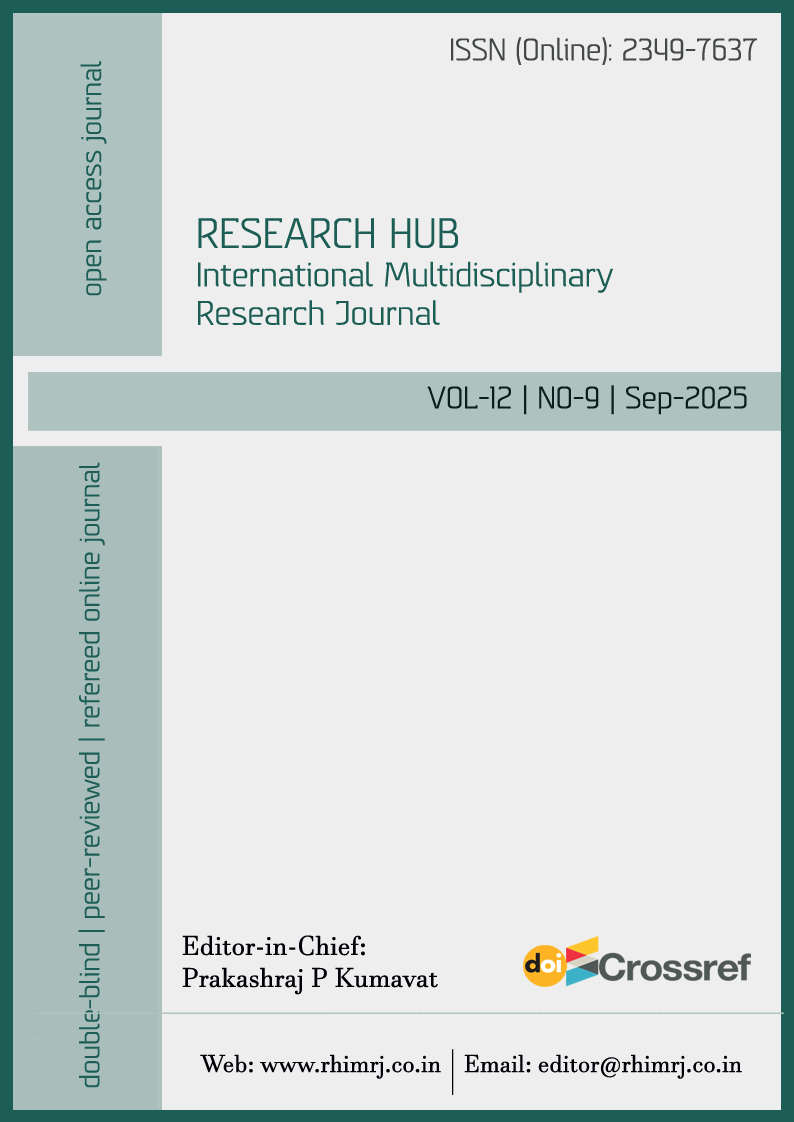Urban Alienation and Postmodern Anxiety in Salman Rushdie’s Fury: A Critical Exploration of Identity, Space and Cosmopolitan Dislocation
DOI:
https://doi.org/10.53573/rhimrj.2025.v12n9.005Keywords:
Urban Alienation, Postmodern Anxiety, Salman Rushdie, Fury, Cosmopolitanism, Identity Crisis and GlobalizationAbstract
Fury (2001) by Salman Rushdie is a book that explores the disenchanted human state where the world has been globalized, displaced and with shifting cultural identities. The novel locates its character, Malik Solanka in the New York City, which is a place of anonymity, gluttony and multiplicity of cultures. Rushdie uses this hyper-urban environment to develop the theme of alienation and anxiety taking over the post-modern experience. Theorists have considered Fury in terms of postmodernism, cosmopolitanism and identity politics. Nonetheless, there is scanty literature linking the urban space with the psychological dislocation and postmodern anxiety. Majority of the critical writing underscores the metafictional devices or diasporic interests of Rushdie but it ignores the city as a dominant influence on identity and anxiety. This paper fills this gap. It aims: (i) to see how Rushdie depicts the theme of urban alienation in Fury, (ii) to see postmodern anxiety as a cultural and psychological, and (iii) to relate the identity crisis of Solanka to the cosmopolitan city of New York. The approach is an amalgamation of close reading with the contributions to postmodern theory, identity studies and the discourse of cosmopolitanism. The discussion reveals that Fury is a postmodern novel that portrays the disintegration of the self in the globalized world. Rushdie examines contemporary urban reality as a disorienting and unstable one, yet he also exposes the fears of the post-modern subject who is in between the opportunities of being a cosmopolitan and the state of existential uncertainty.
References
A. Luburić-Cvijanović and N. Muždeka, “Salman Rushdie from Postmodernism and Postcolonialism to Cosmopolitanism: Toward a Global(ized) Literature?,” Crit. - Stud. Contemp. Fict., vol. 57, no. 4, pp. 433–447, 2016, doi: 10.1080/00111619.2015.1091285.
A. Akkawi, “Salman Rushdie in the Postmodern Current : New Venues , New Values,” 2014.
P. R. Acharya, “New York in Salman Rushdie’s Fury,” Lit. Stud., vol. 29, no. 01, pp. 57–62, 2016, doi: 10.3126/litstud.v29i01.39612.
Y. Liang, “The Spatial Imperative: The Need to Read Space in Salman Rushdie’s Novels,” vol. 43, no. 3, pp. 117–129, 2020.
C. L. Khatri, “Salman Rushdie ’ s Fury : An Exploration of the Self Scanned by CamScanner,” no. October, 2019.
S. Y. Kim, “Ethical treason: Radical cosmopolitanism in Salman Rushdie’s Fury (2001),” Ariel, vol. 42, no. 1, pp. 63–84, 2011.
K. S. Sundarraj, “Depression to Fury : A Psychological Study of Indian Immigrants with Reference to Salman Rushdie ’ s Fury,” vol. 4, no. 3, pp. 19–21, 2020.
“Salman Rushdie ’ s use of Historiographic Metafiction in ‘ Fury ’ Historiographic Metafiction in Fury Historicism dominated literary scholarship up until the 1940s and the emergence of the New,” vol. 9, no. 1, pp. 276–287, 2019.
A. Parthasarathi, “ECO-CRITICAL CONSCIOUSNESS IN SALMAN RUSHDIE ’ S FURY,” no. April 2021, 2023.
D. R. S. -, “Reflections on Identity Crisis in the Twenty-First Century: Salman Rushdie’s Fury,” Int. J. Multidiscip. Res., vol. 6, no. 3, pp. 1–5, 2024, doi: 10.36948/ijfmr.2024.v06i03.23143.
S. Gurunathan, “Strength for Today and Bright Hope for Tomorrow Postmodern Perspectives in Salman Rushdie ’ s Select Novels,” no. July, 2022.
“A STUDY OF WOMEN CHARACTERS IN THE SELECT NOVELS OF SALMAN,” vol. 9, no. 6, pp. 643–645, 2022.
P. Chouhan, “Investigating discourse and identity: A Feminist poststructural perspective on Salman Rushdie's works,” Int. J. Res. English, vol. 7, no. 1, pp. 667–672, 2025, doi: 10.33545/26648717.2025.v7.i1k.405.
B. C. Henry, “Jean- Francois Lyotard ’ s Postmodernism and the Contemporary World,” ARPN J. Sci. Technol., vol. 3, no. 7, pp. 680–682, 2013.
S. Antony and I. A. Tramboo, “Hyperreality in Media and Literature: An Overview of Jean Baudrillard’s Simulacra and Simulation,” Eur. J. Mol. Clin. Med., vol. 7, no. 10, pp. 3314–3318, 2020.
G. Simmel, “The metropolis and mental life,” City Crit. Essays Hum. Geogr., pp. 49–64, 2017, doi: 10.4324/9781003320609-56.
O. Oladapo Makinde, F. Amao, O. Oladapo MAKINDE, and A. Funmilayo Lanrewaju, “Henri Lefebvre Theory of Space and Social Production Philosophy: A Critical Interpretation Global Journal of Arts Humanity and Social Sciences Henri Lefebvre Theory of Space and Social Production Philosophy: A Critical Interpretation BY Article History,” no. February, 2024, doi: 10.5281/zenodo.10577092.
K. A. Appiah, Cosmopolitanism: Ethics in a World of Strangers. 2006.
U. Beck, “The Cosmopolitan State: Redefining power in the global age,” Int. J. Polit. Cult. Soc., vol. 18, no. 3–4, pp. 143–159, 2005, doi: 10.1007/s10767-006-9001-1.
A. C. Das, “International Journal of Research ( Ijr ),” vol. 2, no. 4, pp. 548–577, 2014.



